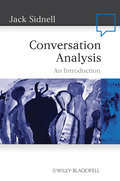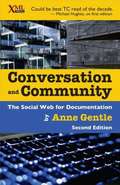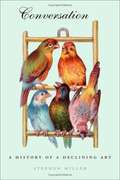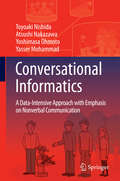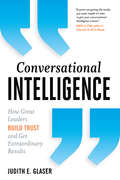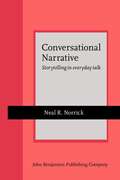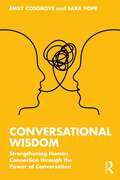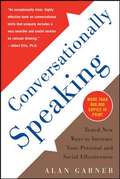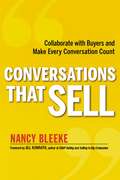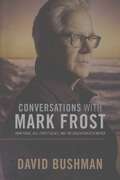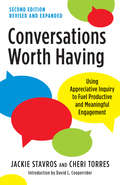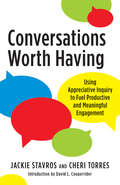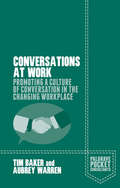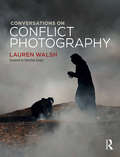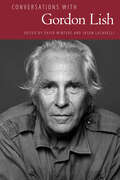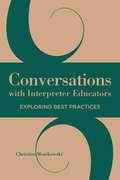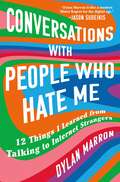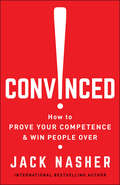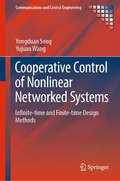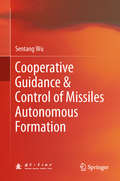- Table View
- List View
Conversation Analysis: An Introduction (Language in Society #45)
by Jack SidnellCombining the main findings, methods and analytic techniques of this central approach to language and social interaction, along with real-life examples and step-by-step explanations, Conversation Analysis is the ideal student guide to the field. Introduces the main findings, methods and analytic techniques of conversation analysis (CA) – a growing interdisciplinary field exploring language and social interaction Provides an engaging historical overview of the field, along with detailed coverage of the key findings in each area of CA and a guide to current research Examines the way talk is composed, and how conversation structures highlight aspects of human behavior Focuses on the most important domains of organization in conversation, including turn-taking, action sequencing, repair, stories, openings and closings, and the effect of context Includes real-life examples and step-by-step explanations, making it an ideal guide for students navigating this growing field
Conversation and Community
by Anne GentleAnne Gentle's Conversation and Community has become the go-to reference for social media and technical communication. Her clear-eyed survey of the social media landscape has been adopted by many universities and is widely used by technical communicators. Now, in this second edition, she has updated and expanded her book, adding chapters on building a content strategy, analyzing web techniques, and developing an open source strategy. With more interviews and case studies, this is your guide to the new world of technical communication and social media. Inside the Book Towards the Future of Documentation Defining a Writer's Role with the Social Web Community and Documentation Commenting and Connecting with Users Wikis as Documentation Systems Finding Your Voice Content Strategy for Community Documentation NEW Chapter Analyzing and Measuring Web Techniques NEW Chapter Open Source Documentation NEW Chapter Concepts and Tools of the Social Web Glossary, Expanded Bibliography, and Index
Conversation: A History of a Declining Art
by Stephen MillerEssayist Stephen Miller pursues a lifelong interest in conversation by taking an historical and philosophical view of the subject. He chronicles the art of conversation in Western civilization from its beginnings in ancient Greece to its apex in eighteenth-century Britain to its current endangered state in America. As Harry G. Frankfurt brought wide attention to the art of bullshit in his recent bestselling On Bullshit, so Miller now brings the art of conversation into the light, revealing why good conversation matters and why it is in decline. Miller explores the conversation about conversation among such great writers as Cicero, Montaigne, Swift, Defoe, Lady Mary Wortley Montagu, and Virginia Woolf. He focuses on the world of British coffeehouses and clubs in "The Age of Conversation" and examines how this era ended. Turning his attention to the United States, the author traces a prolonged decline in the theory and practice of conversation from Benjamin Franklin through Hemingway to Dick Cheney. He cites our technology (iPods, cell phones, and video games) and our insistence on unguarded forthrightness as well as our fear of being judgmental as powerful forces that are likely to diminish the art of conversation.
Conversational Informatics: A Data-Intensive Approach with Emphasis on Nonverbal Communication (Wiley Series In Agent Technology Ser. #9)
by Yasser Mohammad Toyoaki Nishida Atsushi Nakazawa Yoshimasa OhmotoThis book covers an approach to conversational informatics which encompasses science and technology for understanding and augmenting conversation in the network age. A major challenge in engineering is to develop a technology for conveying not just messages but also underlying wisdom. Relevant theories and practices in cognitive linguistics and communication science, as well as techniques developed in computational linguistics and artificial intelligence, are discussed.
Conversational Intelligence: How Great Leaders Build Trust and Get Extraordinary Results
by Judith E. GlaserThe key to success in life and business is to become a master at Conversational Intelligence. It's not about how smart you are, but how open you are to learn new and effective powerful conversational rituals that prime the brain for trust, partnership, and mutual success. Conversational Intelligence translates the wealth of new insights coming out of neuroscience from across the globe, and brings the science down to earth so people can understand and apply it in their everyday lives. Author Judith Glaser presents a framework for knowing what kind of conversations trigger the lower, more primitive brain; and what activates higher-level intelligences such as trust, integrity, empathy, and good judgment. Conversational Intelligence makes complex scientific material simple to understand and apply through a wealth of easy to use tools, examples, conversational rituals, and practices for all levels of an organization.
Conversational Narrative: Storytelling in Everyday Talk (Current Issues in Linguistic Theory #203)
by Neal R. Norrick<p>This book investigates the forms and functions of storytelling in everyday conversation. It develops a rhetoric of everyday storytelling through an integrated approach to both the internal structure and the contextual integration of narrative passages. It aims at a more complete picture of oral narrative through analysis of a wider range of natural data, including personal anecdotes told for humor, put-down stories told for self-aggrandizement, family stories retold to ratify membership and so on, as well as marginal stories and narrative-like passages to delineate the boundaries of conversational storytelling and to test the analytical techniques proposed. <p>Using transcriptions of stories from everyday talk, Norrick explores disfluencies, formulaicity and repetition as teller strategies and listener cues alongside global phenomena such as retelling and narrative macrostructures. He also extends his analysis to narrative jokes from conversation and to narrative passages in drama, namely Shakespeare's “Romeo & Juliet” and Beckett's “Endgame”.</p>
Conversational Repair and Human Understanding (Studies in Interactional Sociolinguistics)
by Jack Sidnell Makoto Hayashi Geoffrey RaymondHumans are imperfect, and problems of speaking, hearing and understanding are pervasive in ordinary interaction. This book examines the way we 'repair' and correct such problems as they arise in conversation and other forms of human interaction. The first book-length study of this topic, it brings together a team of scholars from the fields of anthropology, communication, linguistics and sociology to explore how speakers address problems in their own talk and that of others, and how the practices of repair are interwoven with non-verbal aspects of communication such as gaze and gesture, across a variety of languages. Specific chapters highlight intersections between repair and epistemics, repair and turn construction, and repair and action formation. Aimed at researchers and students in sociolinguistics, speech communication, conversation analysis, anthropology, linguistics, psychology and sociology, this book provides a state-of-the art review of conversational repair, while charting new directions for future study.
Conversational Wisdom: Strengthening Human Connection through the Power of Conversation
by Emily Cosgrove Sara HopeConversation: the heartbeat of our organisations. Right now, we’re at risk of losing the art of doing it well. We need to radically change how we talk to each other, to create workplaces where people feel they belong and can thrive. This book will help you understand how to grow your conversational wisdom to create more inclusive and collaborative environments and to make work more meaningful. Conversations carry the greatest potential to impact culture, performance, brand, and engagement. Yet conversation is an under-rated and under-developed skill. Emily Cosgrove and Sara Hope have spent the last 25 years helping people and organisations strengthen human connection through the power of conversation. Drawing on their experience of working with organisations from global jewellers to charities, professional services to B Corporations, they share a wealth of tips, tools, stories, and case studies. Written in a style that is easy to understand, they offer advice on how to get the best out of conversations and get underneath some of the challenges we all face. This is essential reading for learning and development experts, people leaders, coaches and mentors, and HR managers.
Conversationally Speaking: Tested New Ways To Increase your Personal and Social Effectiveness
by Alan GarnerMore than a million people have learned the secrets of effective conversation using Conversationally Speaking. This revised edition provides more ways to improve conversational skills by asking questions that promote conversation, learning how to listen so that others will be encouraged to talk, reducing anxiety in social situations and more.
Conversations About Illness: Family Preoccupations With Bulimia (Everyday Communication Series)
by Wayne A. BeachThe grandmother granddaughter conversation examined in this book makes explicit what the detailed study of interaction reveals about two social problems--"bulimia" and "grandparent caregiving." For the first time, systematic attention is given to interactional activities through which family members display ordinary yet contradictory concerns about health and illness: * a grandmother's (who is also a registered nurse) attempts to initiate, confront, and remedy her granddaughter's lack of responsibility in admitting bulimic "problems" and committing to professional medical assistance; * a granddaughter's methods for avoiding ownership of the alleged bulimic problems by discounting the legitimacy of her grandmother's expressed concerns. Through analysis of a single audio-recorded and transcribed conversation, Wayne Beach reveals the altogether pervasive and often troubled talk surrounding family medical predicaments. From a careful review of extant theories that seek to explain eating disorders and grandparent caregiving, it becomes clear that an overreliance on self-report data has promoted underspecified understandings of "social contexts" -- conceptualizations void of real time practices and interactional consequences mirroring how families manage their daily affairs and understandings regarding health and illness. In contrast, this volume draws attention to family members' embodied interactional activities. Here it is seen, for example, how methods for expressing concern and caring by individuals may nevertheless eventuate in interactional troubles and problems between family members. The analysis reveals that, while displays of basic concerns for others' health and well being are routine occurrences between family members in home environments -- and of course, across friendship and various support networks -- even the delicate and well-intended management of such occasions guarantees neither agreement on the nature of the alleged "problems" nor, consequently, a commitment to seek professional help as a means of remedying a medical condition. In such cases, the very existence of an illness is itself a matter of some contention to be interactionally worked out. And it is perhaps both predictable and symptomatic that those explicitly denying (or as with the granddaughter, indirectly failing to admit) that problematic health behaviors exist, also somehow let it be made known that far too much attention is being given to possibilities and consequences of illness in the first instance. Implications of this investigation extend well beyond "bulimia" and "grandparent caregiving" to a vast array of casual and institutional involvements between family members, friends, and bureaucratic representatives such as those involved in long-term caregiving, dealing with cancer and Alzheimer's disease, or conducting psychiatric interviews and HIV/AIDS counseling sessions. Findings regarding the interactionally organized nature of talk about bulimia, as well as the problematic nature of caregiving, will be of value to researchers focusing on language and social interaction, health practitioners, and families alike. This volume includes the full transcript of the conversation in the case study. A copy of the audio-recording is available for classroom adoption and/or personal purchase by contacting: Wayne A. Beach, School of Communication, San Diego State University, San Diego, CA 92182-4516.
Conversations That Sell: Collaborate with Buyers and Make Every Conversation Count
by Nancy BleekeThis book introduces sales professionals to the collaborative conversation skills they need to?capture the buyer's attention and secure business.Today's buyers want more from sales professionals than a simple consultation. What they're hungry for are?meaningful, collaborative conversations?built on mutual value and trust, that result in a win...where they, the seller, and the organization, achieve a winning outcome. Based on the author's five-step sales system, What's in It for Them (WIIFT) - Wait, Initiate, Investigate, Facilitate, Then Consolidate - Conversations That Sell shows you how to:Prepare for an?effective sales call - Identify sales opportunities and the factors that?drive buyers to actAdjust their approach?to the type of buyer - Achievers, Commanders, Reflectors, and ExpressersMake conversations flow easily - Address problems, opportunities, wants, and needsWork through objections - Advance and close sales; and morePacked with valuable tools and examples, salespeople in all industries will discover how to increase their short- and long-term sales success by keeping the focus of every conversation where it belongs…on the buyer.
Conversations With Mark Frost: Twin Peaks, Hill Street Blues, and the Education of a Writer
by David BushmanTwin Peaks co-creator Mark Frost dishes about his long and storied career, including his time as a stagehand at Mister Rogers' Neighborhood ; his early days as a a young bachelor in Hollywood rooming with Adam Arkin and Michael O'Keefe; his brief time at Universal TV before chucking it all away to return home to Minnesota to work on documentaries; his experiences in the infamous Hill Street Blues writing room with Steven Bochco and David Milch; and, finally, his career-defining collaboration with David Lynch on Twin Peaks.Mark Frost, cocreator of both the original Twin Peaks and The Return, is often lost in the shadow of co-creator David Lynch in the eyes of critics and scholars -- one newspaper even called him the "Other Peak." In fact, Frost played at least as crucial a role in developing the narrative, mythology, and aesthetic of what has come to be revered as one of the most artful and influential shows ever to air on television. This book, comprising a series of interviews with Frost over the course of a single year, finally and fully acknowledges the extent of Frost's contributions not only to those series, but also to American television in general, as a writer/producer on Hill Street Blues and other shows, and as a mentor to numerous other writers. The book traces the arc of his entire life and career, from his boyhood days in New York, Los Angeles, and Minneapolis, to his nascent playwriting career in Pittsburgh, to his days as a writer at Universal TV's famed factory of the seventies, to his work on Hill Street Blues alongside such industry titans as Steven Bochco and David Milch, to his multiple collaborations with the famously enigmatic Lynch, who perhaps emerges as slightly less enigmatic in the pages of this book. Conversations with Mark Frost deconstructs that legendary partnership, while at the same time exploring Frost's values, influences, thematic preoccupations, and approach to creating art -- for the screen, the stage, and the printed page -- as well as his thoughts about such topics as politics, extraterrestrial life, ethics, and the future of the human race.
Conversations Worth Having, Second Edition: Using Appreciative Inquiry to Fuel Productive and Meaningful Engagement
by Jackie Stavros Cheri TorresNow in a second edition, this classic book shows how to make conversations generative and productive rather than critical and destructive so people, organizations, and communities flourish. We know that conversations influence us, but we rarely stop to think about how much impact they have on our well-being and ability to thrive. This book is the first to show how Appreciative Inquiry—a widely used change method that focuses on identifying what's working and building on it rather than just trying to fix what's broken—can help us communicate more effectively and flourish in all areas of our lives.By focusing on what we want to happen instead of what we want to avoid and asking questions to deepen understanding and increase possibilities, we expand creativity, improve productivity, and unleash potential at work and home. Jackie Stavros and Cheri Torres use real-life examples to illustrate how these two practices and the principles that underlie them foster connection, innovation, and success.This edition has been revised throughout with new examples; updates on the latest supporting research in neuroscience, positive science, and positive psychology; and a discussion guide. It also features a new chapter on what the authors call tuning in: cultivating awareness of how our physical and mental state affect our perceptions, emotions, and thoughts as we engage in conversation. This book teaches you how to use the practices and principles of Appreciative Inquiry to strengthen relationships, build effective teams, and generate possibilities for a future that works for everyone.
Conversations Worth Having: Using Appreciative Inquiry to Fuel Productive and Meaningful Engagement
by David L. Cooperrider Jacqueline M. Stavros Cheri TorresA Unique Guide to Changing Our World of Conversation. Conversation is a crucial part of everything we do. It influences our well being—a good conversation can leave us ready for anything, a bad one can ruin our whole day. But most of us are unaware of the nature of our conversations, let alone how to make them consistently affirming and empowering. This book shows us how to use Appreciative Inquiry, one of the most effective and widely used approaches for fostering positive change, to dramatically improve the outcomes of our conversations. By focusing on what we want to happen instead of what we want to avoid, and asking questions to deepen understanding and increase possibilities, we expand creativity, improve productivity, and unleash potential, at work and home. “This book is for everyone, from managers striving to lead more effectively, to parents trying to cultivate better conversations with children.”Lindsey Godwin, Director, David L. Cooperrider Center for Appreciative Inquiry“Wow! What a great book! I'm going to use it in my courses and with every client. It is rare to read a book that is so compelling and practical with simple guidelines anyone can use.”Gervase R. Bushe, Professor, Simon Fraser University, and author of Clear Leadership “A conversation is the smallest visible unit of change, our starting point for every important change effort. This book is a gift to the world, business, schools, and families!”Jon Berghoff, President, Flourishing Leadership Institute“A must read for all leaders. Practical wisdom and relatable stories!”Robert Easton, Senior Managing Director, Accenture“This short book is a rare gem—entertaining, relevant, educational, and immensely practical.!”Maureen McKenna, Founder, Return on EnergyJackie Stavros and Cheri Torres have been internationally recognized for their work with Appreciative Inquiry. They've positively affected the lives of thousands of people and helped hundreds of organizations improve their capacity to thrive in uncertain times. They have been researching, writing, consulting, and speaking on Appreciative Inquiry since 1996.
Conversations at Work: Promoting a Culture of Conversation in the Changing Workplace (Palgrave Pocket Consultants)
by Tim Baker Aubrey WarrenOrganizations are about conversations. For any organization to achieve its goals, people need to interact and those interactions require dialogue and conversation. Yet, thanks to technology, we seem to be having fewer genuine conversations. This book seeks to change this, through "how to skills" and wider cultural change advice.
Conversations on Conflict Photography
by Lauren WalshIn today’s image-saturated culture, the visual documentation of suffering around the world is more prevalent than ever. Yet instead of always deepening the knowledge or compassion of viewers, conflict photography can result in fatigue or even inspire apathy. Given this tension between the genre’s ostensible goals and its effects, what is the purpose behind taking and showing images of war and crisis? Conversations on Conflict Photography invites readers to think through these issues via conversations with award-winning photographers, as well as leading photo editors and key representatives of the major human rights and humanitarian organizations. Framed by critical-historical essays, these dialogues explore the complexities and ethical dilemmas of this line of work. The practitioners relate the struggles of their craft, from brushes with death on the frontlines to the battles for space, resources, and attention in our media-driven culture. Despite these obstacles, they remain true to a purpose, one that is palpable as they celebrate remarkable success stories: from changing the life of a single individual to raising broad awareness about human rights issues. Opening with an insightful foreword by the renowned Sebastian Junger and richly illustrated with challenging, painful, and sometimes beautiful images, Conversations offers a uniquely rounded examination of the value of conflict photography in today’s world.
Conversations with Gordon Lish (Literary Conversations Series)
by David Winters and Jason LucarelliKnown as "Captain Fiction," Gordon Lish (b. 1934) is among the most influential--and controversial--figures in modern American letters. As an editor at Esquire (1969-1977), Alfred A. Knopf (1977-1994), and The Quarterly (1987-1995) and as a teacher both in and outside the university system, he has worked closely with many of the most pioneering writers of recent times, including Raymond Carver, Don DeLillo, Barry Hannah, Amy Hempel, Sam Lipsyte, and Ben Marcus. A prolific author of stories and novels, Lish has also won a cult following for his own fiction, earning comparisons with Gertrude Stein and Samuel Beckett.Conversations with Gordon Lish collects all of Lish's major interviews, covering the entire span of his extraordinary career. Ranging from 1965 to 2015, these interviews document his pivotal role in the period's defining developments: the impact of the Californian counterculture, the rise and decline of so-called literary "minimalism," dramatic transformations in book and magazine publishing, and the ongoing growth of creative writing instruction. Over time, Lish--a self-described "dynamic conversationalist"-- forges an evolving conversation not only with his interviewers, but with the central trends of twentieth-century literary history.This book will be essential reading not only for students and fans of contemporary fiction, but for writers too: included are several interviews in which Lish discusses his legendary writing classes. Indeed, these pieces themselves amount to a masterclass in Lishian literary language--each is a work of art in its own right.
Conversations with Interpreter Educators: Exploring Best Practices
by Christine MonikowskiSign language interpreter education is a relatively young field that is moving toward more theory-based and research-oriented approaches. The concept of sharing research, which is strongly encouraged in this academic community, inspired Christine Monikowski to develop a volume that collects and distills the best teaching practices of leading academics in the interpreting field. In Conversations with Interpreter Educators, Monikowski assembles a group of 17 professors in the field of sign language interpretation. Through individual interviews conducted via Skype, Monikowski engages them in informal conversations about their teaching experiences and the professional publications that have influenced their teaching philosophies. She guides each conversation by asking these experts to share a scholarly publication that they assign to their students. They discuss the merits of the text and its role in the classroom, which serves to highlight the varying goals each professor sets for students. The complexity of the interpreting task, self-reflection, critical thinking, linguistics, backchannel feedback, and cultural understanding are a sampling of topics explored in these exchanges. Engaging and accessible, Monikowski’s conversations offer evidence-based practices that will inform and inspire her fellow educators.
Conversations with People Who Hate Me: 12 Things I Learned from Talking to Internet Strangers
by Dylan Marron&“Dylan Marron is the internet&’s Love Warrior. His work is fresh, deeply honest, wildly creative, and right on time.&” —Glennon Doyle, #1 New York Times bestselling author &“Dylan Marron is like a modern Mister Rogers for the digital age.&” —Jason Sudeikis From the host of the award-winning, critically acclaimed podcast Conversations with People Who Hate Me comes a thought-provoking, witty, and inspirational exploration of difficult conversations and how to navigate them. Dylan Marron&’s work has racked up millions of views and worldwide support. From his acclaimed Every Single Word video series highlighting the lack of diversity in Hollywood to his web series Sitting in Bathrooms with Trans People, Marron has explored some of today&’s biggest social issues. Yet, according to some strangers on the internet, Marron is a &“moron,&” a &“beta male,&” and a &“talentless hack.&” Rather than running from this online vitriol, Marron began a social experiment in which he invited his detractors to chat with him on the phone—and those conversations revealed surprising and fascinating insights. Now, Marron retraces his journey through a project that connects adversarial strangers in a time of unprecedented division. After years of production and dozens of phone calls, he shares what he&’s learned about having difficult conversations and how having them can help close the ever-growing distance between us. Charmingly candid and refreshingly hopeful, Conversations with People Who Hate Me will serve as both a guide to anyone partaking in difficult conversations and a permission slip for those who dare to believe that connection is possible.
Convinced!: How to Prove Your Competence & Win People Over
by Jack NasherCompetence does not speak for itself! You can't simply display it; you have to draw people's attention to it. World-renowned negotiation and deception detection expert, business professor, and mentalist Jack Nasher offers effective, proven techniques to convince others that we are talented, trustworthy, and yes, even brilliant. Nasher offers the example of Joshua Bell, possibly the world's most famous violinist. In January 2007, at rush hour, he stepped into a Washington, DC, subway station, dressed like any street busker, and began to play a $4,000,000 Stradivarius. It was part of an experiment staged by a journalist of the Washington Post, who expected Bell's skill alone to attract an immense, awed crowd. But Bell was generally ignored, and when he stopped, nobody applauded. He made $34.17.The good news is that you don't have to accept obscurity: you can positively affect others' perception of your talent. Whether you're looking for work, giving an important presentation, seeking clients or customers for your business, or vying for a promotion, Nasher explains how to use techniques such as expectation management, verbal and nonverbal communication, the Halo Effect, competence framing, and the power of nonconformity to gain control of how others perceive you. Competence is the most highly valued professional trait. But it's not enough to be competent, you have to convey your competence. With Nasher's help you can showcase your expertise, receive the recognition you deserve, and achieve lasting success.
Cooperation Between Companies and Non-profit Organizations: Taking Responsibility Together: Guidelines for Constructive, Credible and Transparent CSR Projects
by Gabriele Faber-Wiener Bettina GjecajThis book describes how cooperation between companies and non-profit organizations can be successfully structured. Companies want and need to take on more social responsibility, and joint projects with non-profit organizations are therefore more in demand than ever. This is not about maximizing profits through greenwashing or token commitments, but about serious corporate social responsibility projects and purpose strategies that strengthen the reputation on both sides. This requires a structured, transparent approach from the outset.The authors explain the theoretical basis and provide practical guidance on how the initiation of cooperation projects can lead to a credible and sustainable collaboration with added value for all stakeholders. An elementary part of the book is the "Code for Transparent Cooperation", a proven framework that can be applied directly in practice.A book for CSR, communication, marketing and compliance managers in companiesand non-profit organizations who strive for clear rules and an open dialogue at eye level.Anyone who acts as a credible driver of transformation would do well to operate sustainably themselves. Transparency creates credibility and reliability. The more an organization's goals shape the design of partnerships with companies, the more authentic they can appear to the outside world. This guide provides helpful tips and orientation on how to achieve coherence.Dipl.theol. Yvonne Zwick, Chairwoman of B.A.U.M. e.V. - Network for Sustainable Management, HamburgNon-profit organizations are central pillars of our society. Especially in times of disruption and change, their performance is of increasing importance. The prerequisite for this is independence - also in cooperation with companies. This book helps companies and non-profit organizations to understand their counterparts and establish stable collaborations.Dr. Günther Lutschinger, Managing Director of Fundraising Association Austria, ViennaThe time for lone wolves is over. If we are to achieve the Paris climate targets, companies must offer profitable solutions for people and the planet. It's all about: How do I tackle it? The new book by Gabriele Faber-Wiener and Bettina Gjecaj focuses in particular on partnerships with non-profit organizations and aims to prepare the ground for successful collaboration.Daniela Knieling, Managing Director respACT and Network Representative Global Compact Network Austria, ViennaCredibility, responsibility and transparency are the guarantee and basis for the sustainable development of companies. A thriving, trusting cooperation between companies and non-profit organizations helps to answer political and social questions and is a profound approach to solving complex ecological problems.Ernst Ternon, MBA MSc MSc, Head of Green Marketing, Wieselburg Campus, Wiener Neustadt University of Applied Sciences
Cooperation and Integration in 6G Heterogeneous Networks: Resource Allocation and Networking (Wireless Networks)
by Chunxiao Jiang Jun DuTo provide ubiquitous and various services, 6G networks tend to be more comprehensive and multidimensional by integrating current terrestrial networks with space-/air-based information networks and marine information networks; then, heterogeneous network resources, as well as different types of users and data, will be also integrated. Driven by the exponentially growing demands of multimedia data traffic and computation-heavy applications, 6G heterogenous networks are expected to achieve a high QoS with ultra-reliability and low latency. In response, resource allocation has been considered an important factor that can improve 6G performance directly by configuring heterogeneous communication, computing and caching resources effectively and efficiently. The book addresses a range of technical issues in cooperative resource allocation and information sharing for the future 6G heterogenous networks, from the terrestrial ultra-dense networks and space-based networks to the integrated satellite-terrestrial networks, as well as introducing the effects of cooperative behavior among mobile users on increasing capacity, trustworthiness and privacy. For the cooperative transmission in heterogeneous networks, the authors commence with the traffic offloading problems in terrestrial ultra-dense networks, and the cognitive and cooperative mechanisms in heterogeneous space-based networks, the stability analysis of which is also provided. Moreover, for the cooperative transmission in integrated satellite-terrestrial networks, the authors present a pair of dynamic and adaptive resource allocation strategies for traffic offloading, cooperative beamforming and traffic prediction based cooperative transmission. Later, the authors discuss the cooperative computation and caching resource allocation in heterogeneous networks, with the highlight of providing our current studies on the game theory, auction theory and deep reinforcement learning based approaches. Meanwhile, the authors introduce the cooperative resource and information sharing among users, in which capacity oriented-, trustworthiness oriented-, and privacy oriented cooperative mechanisms are investigated. Finally, the conclusion is drawn.
Cooperative Control of Nonlinear Networked Systems: Infinite-time and Finite-time Design Methods (Communications and Control Engineering)
by Yongduan Song Yujuan WangCooperative Control of Nonlinear Networked Systems is concerned with the distributed cooperative control of multiple networked nonlinear systems in the presence of unknown non-parametric uncertainties and non-vanishing disturbances under certain communication conditions. It covers stability analysis tools and distributed control methods for analyzing and synthesizing nonlinear networked systems. The book presents various solutions to cooperative control problems of multiple networked nonlinear systems on graphs. The book includes various examples with segments of MATLAB® codes for readers to verify, validate, and replicate the results. The authors present a series of new control results for nonlinear networked systems subject to both non-parametric and non-vanishing uncertainties, including the cooperative uniformly ultimately bounded (CUUB) result, finite-time stability result, and finite-time cooperative uniformly ultimately bounded (FT-CUUB) result. With some mathematical tools, such as algebraic graph theory and certain aspects of matrix analysis theory introduced by the authors, the readers can obtain a deeper understanding of the roles of matrix operators as mathematical machinery for cooperative control design for multi-agent systems. Cooperative Control of Nonlinear Networked Systems is a valuable source of information for researchers and engineers in cooperative adaptive control, as its technical contents are presented with examples in full analytical and numerical detail, and graphically illustrated for easy-to-understand results. Scientists in research institutes and academics in universities working on nonlinear systems, adaptive control and distributed control will find the book of interest, as it contains multi-disciplinary problems and covers different areas of research.
Cooperative Coverage Control of Multi-Agent Systems and its Applications (Studies in Systems, Decision and Control #408)
by Gaoxi Xiao Chao Zhai Hai-Tao ZhangThis book highlights cooperative coverage control approaches of multi-agent systems in uncertain environments and their applications in various fields. A novel theoretical formulation of multi-agent coverage is proposed to fulfill the coverage task via divide-and-conquer scheme. By taking workload partition and sweeping operations simultaneously, a distributed sweep coverage algorithm of multi-agent systems is developed to cooperatively complete the workload on the given region, and its input-to-state stability is guaranteed in theory. Moreover, the coverage performance is evaluated by estimating the error between the actual coverage time and the optimal time. Three application scenarios are presented to demonstrate the advantages of cooperative coverage control approaches in missile interception, intelligent transportation systems and environment monitoring, respectively.
Cooperative Guidance & Control of Missiles Autonomous Formation
by Sentang WuThis book primarily illustrates the rationale, design and technical realization/verification for the cooperative guidance and control systems (CGCSs) of missile autonomous formation (MAF). From the seven functions to the five major compositions of CGCS, the book systematically explains the theory and modeling, analysis, synthesis and design of CGCSs for MAF, including bionics-based theories.Further, the book addresses how to create corresponding digital simulation analysis systems, as well as hardware in the loop (HIL) simulation test systems and flight test systems, to evaluate the combat effectiveness of MAF. Lastly, it provides detailed information on digital simulation analysis for a large range of wind tunnel test data, as well as test results of HIL system simulations and embedded systems testing.
